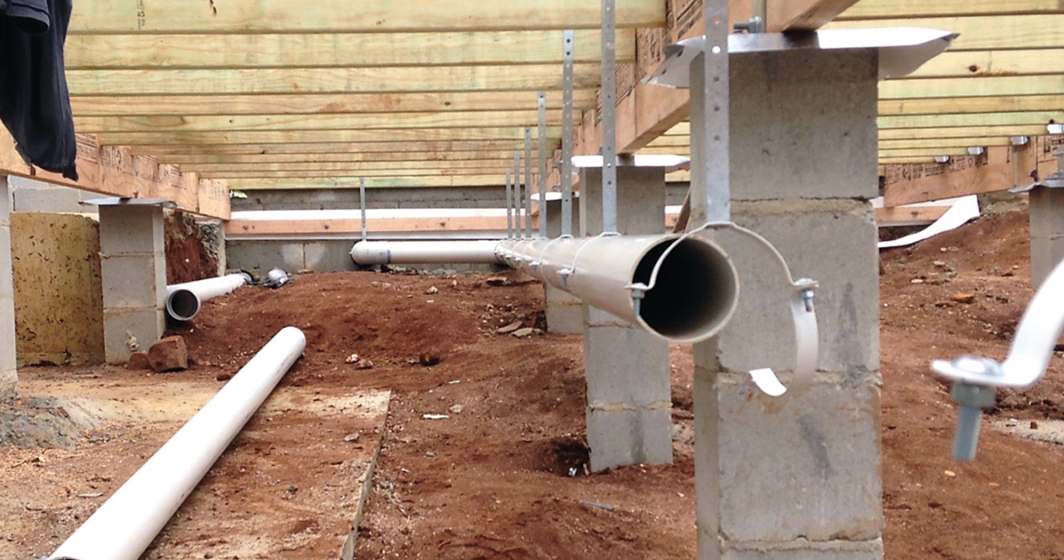Give UPVC room to move or face the consequences, Aaron Bridger, Master Plumbers Technical Adviser, writes.
When installing above-ground PVC and polyethylene sanitary pipework, plumbers need to make allowance for the potential pipe expansion and/ or contraction. A six-metre length of 100mm UPVC pipe can increase in length by 20mm when exposed to outside temperatures of 50°C or more. The stress caused between two fixed points can lead to failure of the integrity of the pipework, eventuating in costly damages.

Whilst UPVC has been around for a considerable time, many of the requirements for installing this lightweight pipe seem to have been forgotten, particularly when it is exposed to extremes of temperature from both internal liquids and outside temperatures.
The spacing and types of supports used for UPVC installations and even the colour they are painted can have an effect, ranging from the aesthetics of a painted UPVC downpipe where the expansion through the clip head exposes an unpainted surface, through to suspended sanitary drainage systems failing because of cracked pipework or fittings resulting in thousands of dollars in damages.
UPVC must be able to move. This movement can increase due to the temperature of the water within it or a temperature difference caused by environmental conditions. Here are some installation requirements to remember.
Hot and cold pipelines
Something you need to consider in the provision for expansion is the temperature of the pipe contents. The temperature of the products running through the pipe have a significant effect on the UPVC.
Higher temperature products cause greater expansion, requiring a more frequent allowance for expansion. The temperature range is categorised below.
Hot pipeline: 60 degrees and above. These include sanitary drains connected to dishwashers, washing machines, boiling water units, etc and include pipe work which might be located outside of buildings in direct sunlight.
Cold pipeline: up to 60 degrees. Given that this increase in temperature can impact on the amount of expansion that is required, provisions for thermal expansion are required in the following areas.
At spacings no greater than 6m for cold pipelines or 4m for hot pipelines and between two fixed points if:
- The pipe length exceeds 2m for cold pipelines
- The pipe length exceeds 1m for hot pipelines
Note: a fixed point is defined as a point at which the axial movement of the pipe or fitting is restrained:
- At the fixed (clipped) part of an expansion joint fitting
- At junctions and bends except where alternative provision for expansion is made
- At connections to fixtures (except where movement is accommodated at a trap) and drains (except where movement is possible at the drain connection)
The requirements for expansion are usually met using expansion joints. There are other ways of meeting the requirements to allow for thermal expansion in PVC pipelines, which allow the expansion joint to be omitted, such as:
- Plastic trap installation A plastic trap installed in line with the pipeline, allows for the expansion joint to be omitted, where it would otherwise be required.
- Movement through penetration Where the pipeline passes through a weatherproof roof penetration. The expansion joint may be omitted, if the pipeline has free movement through the flashing and roof, eg: upstand and weathering collar or Dektite.
- Sleeve into drainage trap If a sleeve is provided into a drainage trap, allowing for free movement of the pipeline. For example, when running a discharge into frog mouth, if the discharge pipe is sleeved through the mortar, this allows for pipeline movement.
- Deflection of pipe At a junction or bend in a graded pipeline where the thermal movement is accommodated by the deflection in the offset leg, ensuring it does not affect the grade of the pipeline. This can be achieved by meeting the distances set out in the in the table below.
Alternative expansion provision
| Nominal size of pipe, mm | Maximum length of pipe, m | Minimum length of offset |
| 32, 40, 50 | 2.0 | 0.5 |
| 3.0 | 0.6 | |
| 4.0 | 0.8 | |
| 6.0 | 1.0 | |
| 65, 80, 100 | 2.0 | 0.75 |
| 3.0 | 1.0 | |
| 4.0 | 1.1 | |
| 6.0 | 1.2 | |
| 150 | 2.0 | 1.0 |
| 3.0 | 1.1 | |
| 4.0 | 1.2 | |
| 6.0 | 1.2 |
Share this Article






